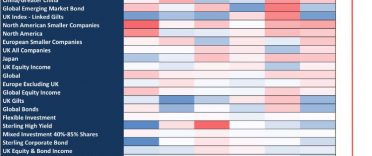 When it comes to investing, there are two main ways in which you can invest: for growth or for income. You may choose to focus on one style or the other, or you may incorporate a combination of growth and income. The way you choose to invest may alter throughout your lifetime as your goals and appetite for risk change.
When it comes to investing, there are two main ways in which you can invest: for growth or for income. You may choose to focus on one style or the other, or you may incorporate a combination of growth and income. The way you choose to invest may alter throughout your lifetime as your goals and appetite for risk change.
In this article, we look at what investing for growth and income mean, the benefits of each approach and the types of investments usually associated with each one.
What is growth investing?
Investing for growth means focusing primarily on capital appreciation - in other words, growing the money in your investment pot. Generally, this means investing in assets like equities, which offer the potential to grow more rapidly over time and, therefore, give a better return. However, there is traditionally a greater level of volatility and risk associated with this type of investment.
If you are investing with an eye on growth, you might opt to invest in a fund, which pools investors' money together and primarily targets strong growth. If you choose an actively managed fund, the fund manager will aim to select stocks that have above-average potential for growth over a certain timeframe. If instead, you prefer passive investments, you could choose a vehicle that tracks an index or sector with a high proportion of growth stocks.
True growth investments typically offer low or no dividends. However, for those that do, it is possible to opt to reinvest any income you earn. You can do this by choosing the specific share class of a fund which automatically reinvests any dividends received.
How to invest for growth
Equities
If you are investing with growth in mind, you will more than likely have a high allocation to equities, which generally have the greatest capacity for capital appreciation over time, albeit with higher levels of volatility than some other asset classes. Within this asset class, there are certain sectors and areas of the market that offer higher levels of growth, on average. As such, you may wish to target small-cap companies, which have more scope for growth over the medium term than some of their large-cap equivalents. There is also generally more growth potential in emerging markets or in certain industry sectors, such as technology.
It can be difficult to construct a portfolio of individual shares that offer consistent growth potential with an appropriate level of risk, so you may prefer to invest in an equity fund that has a growth focus. Alternatively, you could opt for a multi-asset fund that has a higher weighting in equities but also combines other growth assets for greater diversification.
Bonds
Bonds are essentially a loan to a company or government in return for income payments over the agreed term followed by a return of your original capital. I go into more detail about bonds in the "What is income investing" section below, as they are often most associated with income investing. However, bonds will also often make up a portion of a growth portfolio as they are a good diversifier to equities. Bonds are usually viewed as lower-risk investments, depending on the type of bond, than investing in equities and can help preserve capital during periods of stock market volatility.
Commodities
Investing in commodities - including precious metals, oil, gas and agricultural goods - is another way of promoting growth in your investment portfolio. You can do this in a number of ways, including buying the physical asset, although for most investors it will be through investing in an ETF. The ETF may purely be made up of a single commodity, such as gold, or maybe a basket of different commodities. Another way to invest in commodities is by buying shares in companies that produce or mine them.
Cryptocurrencies
A relatively new asset class that offers growth potential is cryptocurrencies, which includes bitcoin. It is growing in popularity, particularly among younger investors. It is, however, highly volatile, unregulated and investors need to be aware of the risks before investing. We provide more information in our article "A beginner's guide to investing in bitcoin and cryptocurrency".
What is income investing?
Investing for income means looking for a steady stream of income from your investment pot. With this approach, while you will be looking to preserve your capital, or perhaps moderately grow it, your principle focus is on generating a regular income. You may require this income to meet a regular financial commitment, such as private school fees, or during retirement, when you may be less concerned with growing your capital and more interested in using the income from your existing investment pot to meet living costs.
The main ways of achieving an income from your investments is either through investing in stocks that pay out a dividend or through corporate or government bonds, which pay out a regular coupon and return your original capital at the end of the term. There are several key differences between the income generated through dividends from equities or through bonds:
Income from dividends
Companies tend to pay out dividends to shareholders either quarterly or once or twice a year. The amount paid is linked to a share of the profits the company has made over that period. While certain types of companies may have a track record of paying out generous dividends, it is important to note that these payments aren't guaranteed. A company can choose to reduce the amount it pays out, or opt not to pay a dividend at all. This means dividends can be an unstable form of income and, in that respect, carry a greater level of risk. However, because dividends are linked to a company's profits they can provide an income stream that grows over time, keeping pace with inflation.
Income from bonds
When you buy a bond from a company or government, you are in effect lending them money. In return you receive a regular interest payment and then get the amount you initially paid at the outset back at the end of the term. The good thing about the income from bonds is that they have a certain level of guarantee as the company or government is contractually obliged to make the payments. However, they aren't completely risk-free as there is a chance the company or government will default on the loan. This is why bonds are given a risk-rating, which gives an indication of the level of default risk.
Another way of investing in bonds for income is through a bond fund, which is a pooled investment where a manager will buy and sell bonds on the secondary market, making money on the difference in price and yield on individual bonds over their lifetime. In theory, this spreads the default risk and can generate capital growth as well as income. Unless stipulated in the bond contract, the income generated by a bond each year will remain fixed and won't grow over time and therefore its real value (purchasing power) can be eroded by inflation.
How to invest for income
Equities
When investing in equities to generate an income, you are specifically looking for shares in companies that have a good track record of paying dividends to their shareholders. When looking at the market sectors that generally offer the best dividends, the utilities sector is a clear favourite, with relatively high yields and low levels of volatility. Telecoms, tobacco and oil and gas companies have all also typically offered good dividend yields. Equity income funds tend to invest in companies from these sectors, although not exclusively.
Bonds
Government bonds are seen as being one of the lowest-risk investments, although they also offer relatively low yields for income investors. Corporate bonds, meanwhile, can offer a more attractive level of income, but, depending on the company, can have a higher risk of defaulting. You will receive a regular "coupon", which is the interest payment, as well as getting your original investment (the "principal") back at the end of the agreed term. Investing in short-dated bonds carries less risk, but a longer-dated bond can offer a greater return.
Cash
A straightforward way of earning an income from a lump sum is by holding it in a cash savings account. The downside of holding cash to generate income is that interest rates can be extremely low. This not only means that you may not achieve the income level you need, but also that your capital is subject to inflation risk. This is when the rate of inflation is higher than the interest rate you are getting, which means the value of your money erodes over time.
How to balance growth and income investments
Although you may choose to invest with a particular aim in mind, you will generally want to achieve diversification and balance in your portfolio. As such, while a lot of investors may prioritise growth for the majority of their investment journey and then move to wanting a regular income as they get closer to retirement, they will also generally include different asset classes within their portfolios, perhaps choosing to reinvest any income generated to further drive growth.
For some investors, their aim may be to achieve a good level of return with a regular income at the same time. There are several ways to do this:
Investing in an equity income fund
An equity income fund is designed to straddle both growth and income. The manager will typically target stocks that have higher-than-average growth potential, but that also offer good dividend potential. While they tend to have higher levels of volatility than a bond fund, the fact they incorporate dividend-paying companies, which tend to be larger, well-established businesses, can help minimise the highs and lows normally associated with high-growth funds. There is also the option to reinvest the income component, if it isn't required to meet an existing financial commitment.
Investing in property
Investing in bricks-and-mortar, either buying a property outright or with a buy-to-let mortgage, has the potential to offer growth in the form of capital appreciation, but also the promise of a regular income if you rent the property out. While this is an attractive option for many people, it does come with a certain element of risk, not least the fact that it is an illiquid asset. This means your money is tied up and can't easily be accessed. There have also been several major housing market corrections over the years, which means it isn't guaranteed you will benefit from the value of the property going up. This is particularly true if you need to sell the property during a downturn. Check out our "Complete buy-to-let guide" for more information on investing in property.
The other option is to invest in commercial property through a real-estate investment trust (REIT). These vehicles potentially offer both capital growth and a regular income, although there is no guarantee of either and the value of the investment can go down as well as up.
Summary - Should you invest for growth or income?
The question of whether you should invest with a focus on growth or income will largely come down to what you need from your investment. If you require an income to meet certain costs, for example school fees or funding retirement, then it makes sense to invest in assets that will yield sufficient income to meet those costs. However, if you are early on in your investment journey and have a long time horizon, you may wish to prioritise capital appreciation.
Whether investing for income or growth it is desirable to achieve a good level of diversification across your investments, which generally means balancing asset classes into a portfolio in order to mitigate investment risks.



